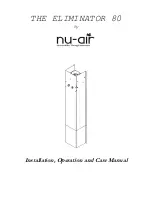
19
DTX10 - DTX80 USER GUIDE
12. High Humidity
12.1
Principle of Operation
The High Humidity Alarm (HHA) are circuits designed to function in conjunction with a Hygrosensor to
provide on/off control for compressed air dryers. The HHA can also provide an alarm when humidity
conditions exceed or go below a fixed setpoint.
Operation of the controller is based on relay actuation at a predetermined resistance value. The
resistance of the humidity sensor (a Dunmore-type lithium chloride element) varies inversely proportional
to the relative humidity to which it is exposed. The controller supplies a constant excitation voltage
to the sensor and the change in resistance is measured. When the relative humidity reaches the
selected setpoint (-20°F, -29°C), the controller detects the corresponding resistance and activates a
single pole, double throw relay.
The controller is set to activate at a predetermined resistance value by using a setplug whose
resistance corresponds to the sensor resistance at a particular relative humidity condition (-20°F).
12.2
System Components
POWER: 12-/220 VAC + 10%, 50-60Hz, 1 Watt DIMENSIONS: PC Board 3.5 x 2.75 x 1.1 inches
OPERATING TEMPERATURE: + 15°F (-9.4°C) to 140°F(60°C) STORAGE TEMPERATURE: -40°F (-40°C)
to +200°F (93°C).
CAUTION! HHA IS POWERED UP DURING THIS PROCEDURE. USE CAUTION NOT TO TOUCH
LIVE EXPOSED TERMINALS.
12.3
Calibration Procedure
1.
Remove the sensor input terminals and replace it with the appropriate setplug.
2.
Adjust potentiometer P1 to the midpoint between the relay “pull-in” and “drop-out”.
3.
Replace the setplug with the sensor. The unit is now ready for operation.
12.4
Precautions, Limitations, and Hazards
The HHA Controller uses 115 VAC. Avoid contact with exposed terminals when performing set
point adjustment.
Never test the sensor with an ohmmeter or other DC measuring device. To do so will permanently
damage the sensor.
Do not expose sensors to humidity’s at which condensation is likely to occur, nor to sprays or water
droplets in ducts and air exhausts.
Do not expose sensors to air stream carrying dust, soot, or other containments, unless properly
protected by baffle, 200 by 200 mesh screen, cellophane, or tissue paper wrap to prevent impingement
of particles on the sensing surfaces.











































